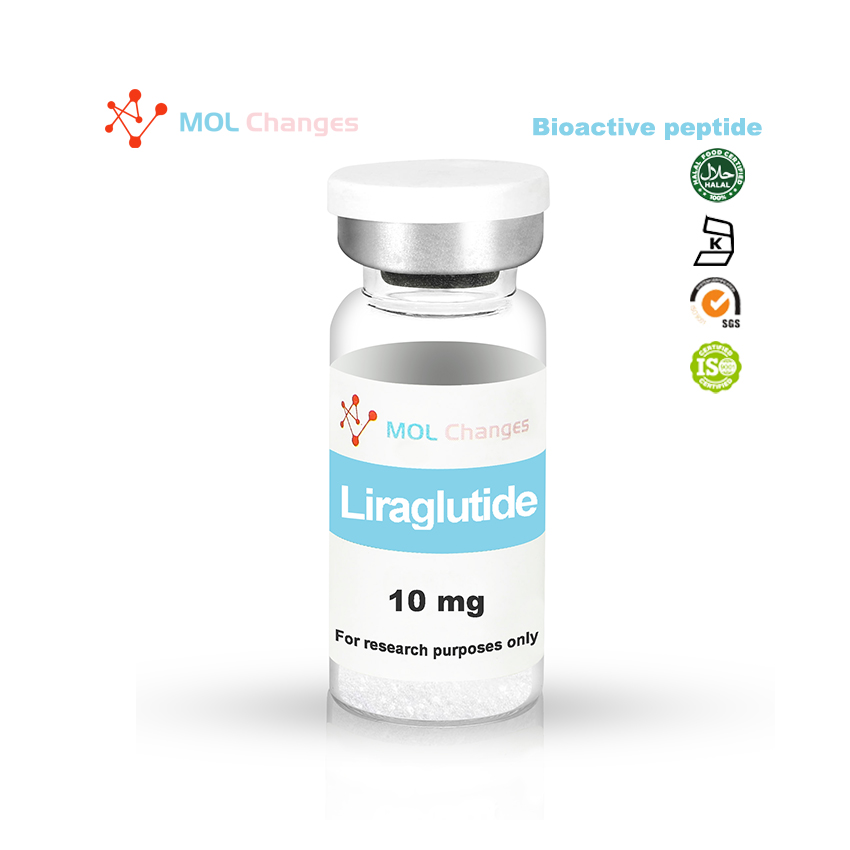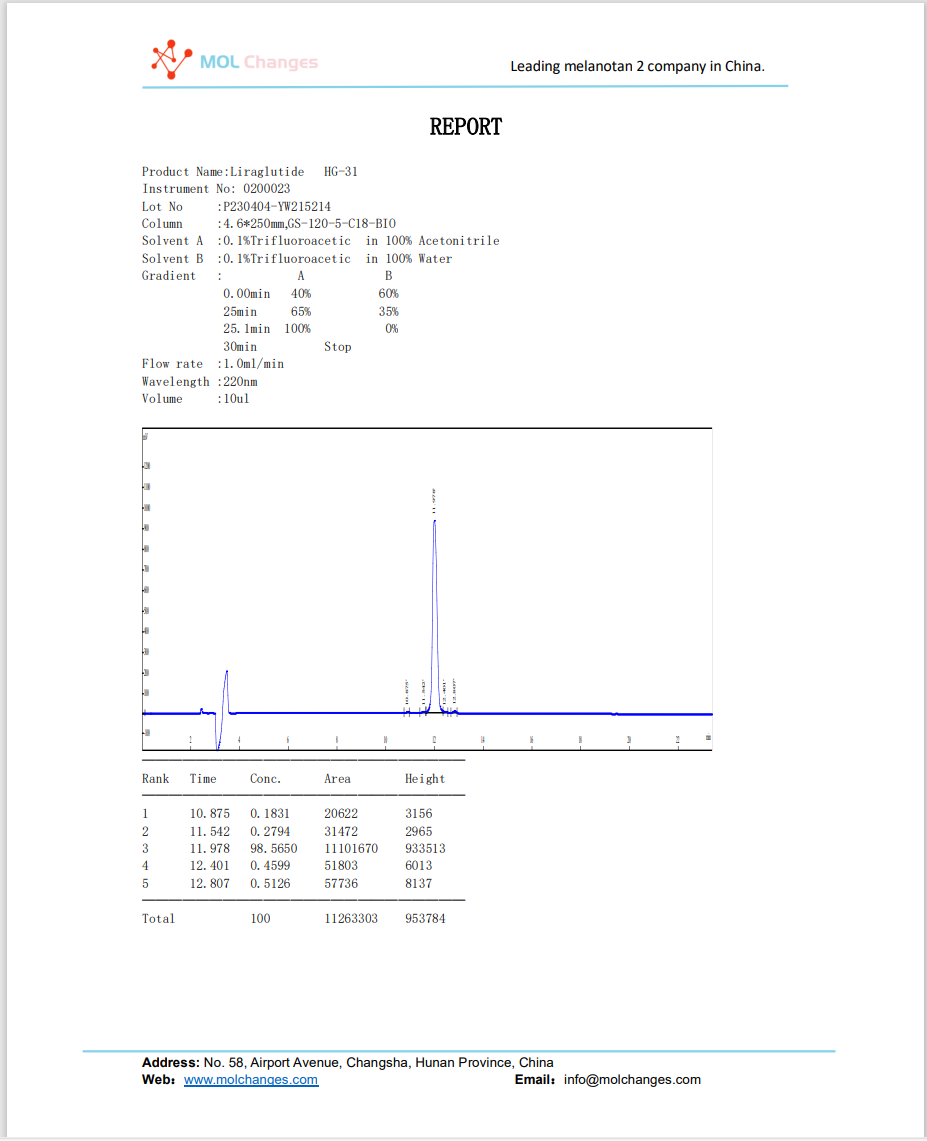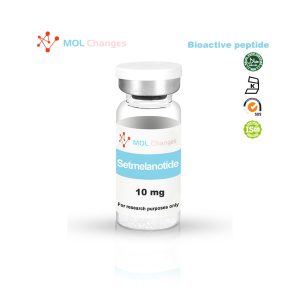Liraglutide
Liraglutide works by mimicking the activity of the glucagon-like peptide-1 (GLP-1) hormone, which the body routinely produces after eating.
$12.00 – $21.00
WhatsApp us
◐ Bulk price on WhatsApp!
◐ MOQ: 10 pieces
◐ Peptide manufacturing plant
◐ Implementation of CGMP standards
◐ ISO9001 & ISO14000
SHARE THIS

Liraglutide Product information navigation
Liraglutide Structure
- Sequence:HAEGTFTSDVSSYLEGQAALEFIATLVRGRG-OH.palmitoyl-E
- CAS Number:204656-20-2
- Molecular Formula:C172H265N43O51
- Molecular Weight: 3751.24 g/mol
What is Liraglutide?
Liraglutide is a GLP-1 Analogue,GLP-1 stands for glucagon-like peptide-1, a short, naturally occurring peptide hormone that is only 30-31 amino acids in length. Its main physiological function is to lower blood glucose levels by naturally enhancing insulin secretion. It also protects beta-cell insulin stores by promoting insulin gene transcription and has been implicated in neurotrophic effects in the brain and central nervous system. In the gastrointestinal system, GLP-1 has been shown to significantly reduce appetite by delaying gastric emptying and reducing intestinal motility. Preliminary studies suggest that GLP-1 also has effects on the heart, fat, muscle, bone, liver, lungs, and kidneys.
The primary focus of GLP-1 research has been in the areas of diabetes treatment/prevention and appetite suppression. Secondary research has focused on the potential cardiovascular benefits of the peptide. More recent, and therefore less robust, research has focused on GLP-1’s ability to prevent neurodegenerative diseases. Although this latter area of research is the most recent, it is also an area of rapid growth in GLP-1 research, as the peptide has been shown to slow or prevent the accumulation of beta-amyloid plaques in Alzheimer’s disease.
Liraglutide Effects
Enteric insulinotropic effects of GLP-1
According to Dr. Holst, perhaps the most important role of GLP-1 is called “enteroglucagon”. Glucagon is a group of metabolic hormones released by the gastrointestinal tract that cause a decrease in blood glucose (sugar) levels, and GLP-1 has been shown to be one of the two most important hormones stimulating the action of glucagon in rodent models (the other being GIP). Although circulating levels of GIP are approximately 10-fold higher than those of GLP-1, there is evidence that GLP-1 is the more potent of the two molecules, especially when blood glucose levels are quite high.
GLP-1 receptors have been found on the surface of pancreatic beta cells, suggesting that GLP-1 directly stimulates the cytosolic action of insulin in the pancreas. When used in combination with sulfonylureas, GLP-1 has been shown to promote insulin secretion sufficiently to cause mild hypoglycemia in up to 40% of subjects, and, of course, increased insulin secretion is associated with a number of trophic effects, including increased protein synthesis, decreased protein catabolism, and increased uptake of amino acids by skeletal muscle.
GLP-1 and Beta Cytoprotection
Studies in animal models have shown that GLP-1 stimulates the growth and proliferation of pancreatic β-cells and may stimulate the differentiation of new β-cells into progenitor cells in the pancreatic ductal epithelium. Studies have also shown that GLP-1 inhibits β-cell apoptosis, and overall, these effects shift the usual balance of β-cell growth and death toward growth, suggesting that the peptide may be useful in treating diabetes and protecting the pancreas from damage that compromises β-cells.
In one particularly compelling trial, GLP-1 was shown to inhibit β-cell death caused by elevated levels of inflammatory cytokines. In fact, mouse models of type 1 diabetes suggest that GLP-1 protects islet cells from destruction and may actually be useful in preventing the onset of type 1 diabetes.
GLP-1 and Appetite
Studies in mice have shown that injecting GLP-1 and its analog, GLP-1, into the brains of mice reduces the drive to eat and suppresses food intake. It appears that GLP-1 may actually enhance satiety, helping individuals feel fuller and indirectly reducing hunger. Recent clinical studies have shown that twice-daily administration of a GLP-1 receptor agonist to mice results in gradual linear weight loss. Over a long period of time, this weight loss was associated with significant improvements in cardiovascular risk factors and reductions in glycated hemoglobin levels, which are surrogate markers of diabetes severity and the quality of glycemic control achieved through treatment.
Potential cardiovascular benefits of GLP-1
It is now known that GLP-1 receptors are distributed throughout the heart and in some cases improve cardiac function by increasing heart rate and decreasing left ventricular end-diastolic pressure (LVEDP), the latter of which may not seem like much, but elevated LVEDP has been associated with left ventricular hypertrophy, cardiac remodeling, and ultimately heart failure.
Recent evidence even suggests that GLP-1 may play a role in reducing the overall damage caused by heart attacks. The peptide appears to improve myocardial glucose uptake, thereby helping cardiomyocytes in an ischemic state to receive the nutrients they need to continue functioning and avoid programmed cell death. The increase in glucose uptake in these cells appears to be independent of insulin.
Massive infusions of GLP-1 to dogs have been shown to improve left ventricular function and reduce systemic vascular resistance. The latter effect may help lower blood pressure and relieve cardiac stress, which in turn may help reduce the long-term consequences of hypertension, such as left ventricular remodeling, vascular thickening, and heart failure. Dr. Holst said that administration of GLP-1 after cardiac injury “consistently improves myocardial performance in experimental animal models and in patients.”
GLP-1 and the Brain
There is some evidence that GLP-1 may improve learning and help protect neurons from neurodegenerative diseases such as Alzheimer’s disease. One study showed that GLP-1 can enhance associative and spatial learning in mice, and even improve learning deficits in mice with specific genetic defects. In rats that overexpressed GLP-1 receptors in certain areas of the brain, learning and memory were significantly better than in normal controls.
Other studies in mice have shown that GLP-1 helps prevent excitotoxic neuronal damage and completely protects against glutamate-induced apoptosis in a neurodegenerative rat model. The peptide even stimulated neurite growth in cultured cells. The researchers hope that further studies of GLP-1 will reveal how it can be used to stop or reverse certain neurodegenerative diseases.
Interestingly, GLP-1 and its analog exendin-4 have been shown in mouse models to reduce levels of β-amyloid in the brain as well as β-amyloid precursor proteins found in neurons. β-amyloid is a major component of the plaques observed in Alzheimer’s disease, and while plaques are not necessarily known to be causative of the disease, they correlate with the severity of the disease. Whether preventing beta amyloid accumulation prevents the effects of Alzheimer’s disease remains to be seen, but the study offers at least one tantalizing clue as to how scientists might intervene in the progression from mild cognitive impairment to full-blown Alzheimer’s disease.
Referenced Citations
- “The Physiology of Glucagon-like Peptide 1 | Physiological Reviews.” [Online].
- “Combined treatment with lisofylline and exendin-4 reverses autoimmune diabetes. – PubMed – NCBI.” [Online].
- “The proglucagon-derived peptide, glucagon-like peptide-2, is a neurotransmitter involved in the regulation of food intake. – PubMed – NCBI.” [Online].
- “Interim analysis of the effects of exenatide treatment on A1C, weight and cardiovascular risk factors over 82 weeks in 314 overweight patients with… – PubMed – NCBI.” [Online].
- “Cardiac function in mice lacking the glucagon-like peptide-1 receptor. – PubMed – NCBI.” [Online].
- “Glucagon-like Peptide 1 Can Directly Protect the Heart Against Ischemia/Reperfusion Injury | Diabetes.” [Online].
- “Recombinant glucagon-like peptide-1 increases myocardial glucose uptake and improves left ventricular performance in conscious dogs with pacing-ind… – PubMed – NCBI.” [Online].
- “Glucagon-like peptide-1 receptor is involved in learning and neuroprotection. – PubMed – NCBI.” [Online].
- “Protection and reversal of excitotoxic neuronal damage by glucagon-like peptide-1 and exendin-4. – PubMed – NCBI.” [Online].
- “A new Alzheimer’s disease interventive strategy: GLP-1. – PubMed – NCBI.” [Online].
- Holst JJ. From the Incretin Concept and the Discovery of GLP-1 to Today’s Diabetes Therapy. Front Endocrinol (Lausanne). 2019;10:260. Published 2019 Apr 26. doi:10.3389/fendo.2019.00260 https://www.ncbi.nlm.nih.gov/pmc/articles/PMC6497767/
ALL ARTICLES AND PRODUCT INFORMATION PROVIDED ON THIS WEBSITE ARE FOR INFORMATONAL AND EDUCATIONAL PURPOSES ONLY.
In no way does this doctor/scientist endorse or advocate the purchase, sale, or use of this product for any reason. MOL Changes has no affiliation or relationship, implied or otherwise, with this physician. The purpose of citing this doctor is to acknowledge, acknowledge and commend the exhaustive research and development work done by the scientists working on this peptide.
HPLC test report
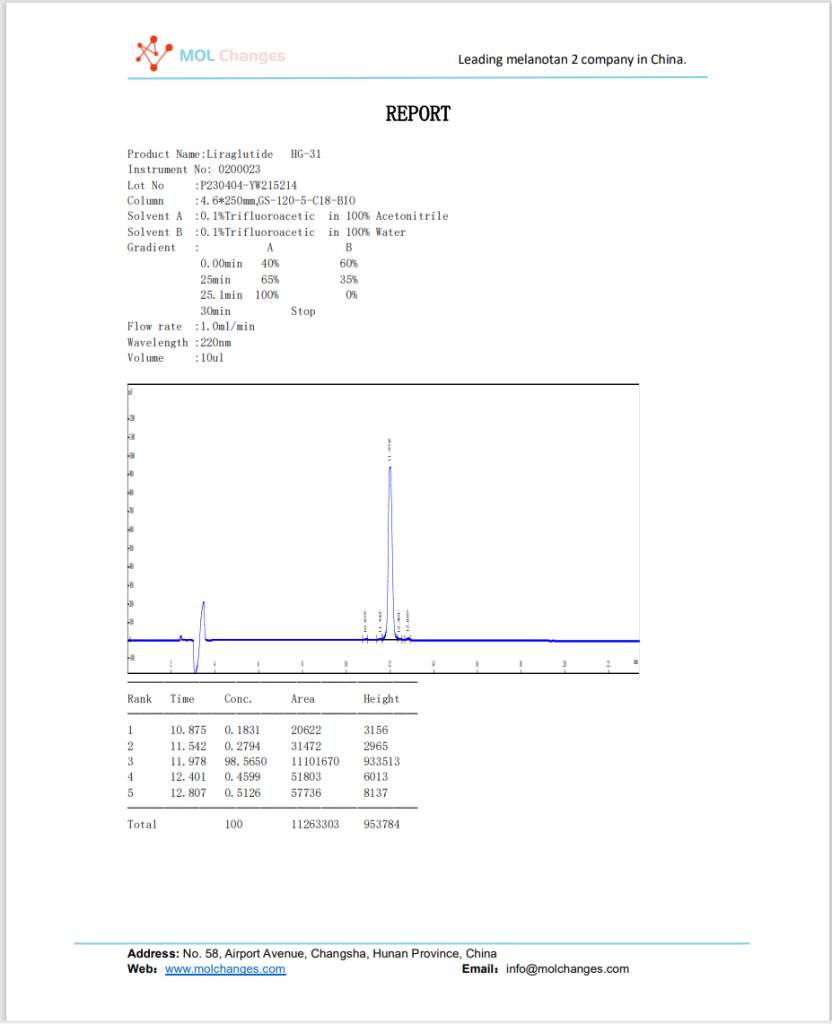
MS test report
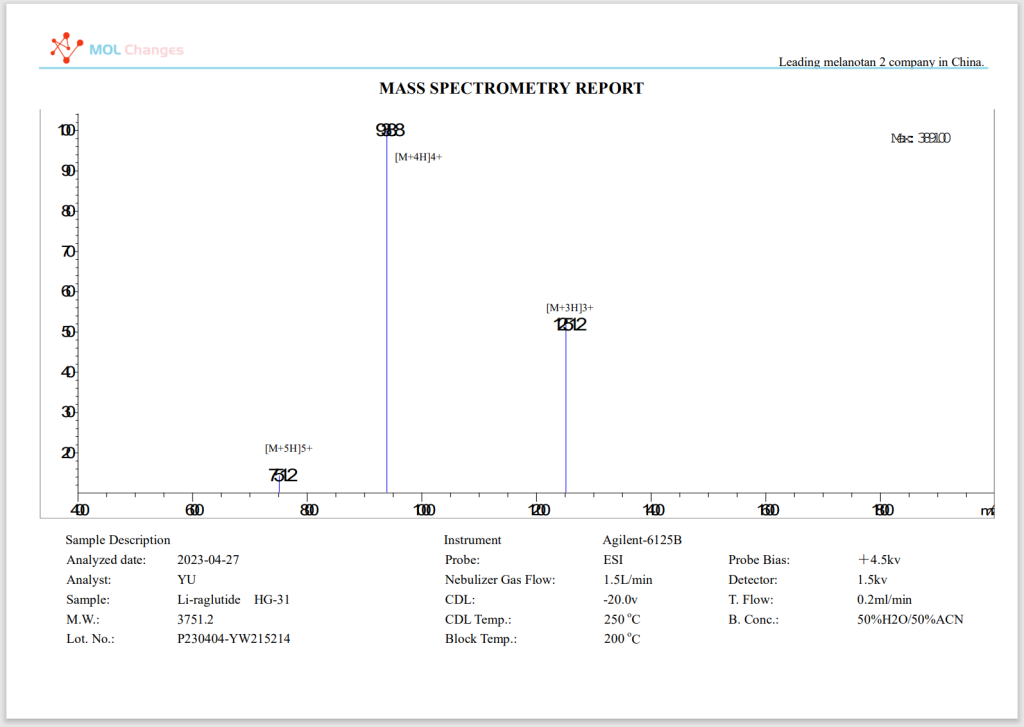
Manufacturer Information
- Liraglutide is manufactured by MOL Changes factory.
- Liraglutide supplier MOL Changes.
- Maximum acceptable production volume: 100000 bottles.
- Content standard: net peptide.
- Purity: ≥98% for all products.
- Customization: 1mg-1g size customization is acceptable

